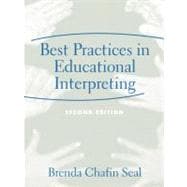
| Preface | xiii | ||||
| Acknowledgments | xvii | ||||
| 1 Educational Interpreting: An Introduction | 1 | (16) | |||
|
1 | (5) | |||
|
6 | (1) | |||
|
7 | (1) | |||
|
8 | (2) | |||
|
10 | (3) | |||
|
13 | (2) | |||
|
15 | (2) | |||
| 2 Best Practices in the Administration of Educational Interpreting Services | 17 | (29) | |||
|
18 | (1) | |||
|
19 | (1) | |||
|
20 | (4) | |||
|
24 | (2) | |||
|
26 | (10) | |||
|
36 | (8) | |||
|
36 | (1) | |||
|
37 | (1) | |||
|
38 | (1) | |||
|
39 | (1) | |||
|
40 | (1) | |||
|
41 | (2) | |||
|
43 | (1) | |||
|
44 | (1) | |||
|
44 | (2) | |||
| 3 Best Practices in Educational Interpreting in the Primary Grades Setting | 46 | (35) | |||
|
46 | (7) | |||
|
53 | (2) | |||
|
55 | (2) | |||
|
57 | (4) | |||
|
61 | (3) | |||
|
64 | (1) | |||
|
65 | (2) | |||
|
67 | (1) | |||
|
68 | (1) | |||
|
69 | (8) | |||
|
69 | (2) | |||
|
71 | (1) | |||
|
72 | (1) | |||
|
73 | (1) | |||
|
74 | (1) | |||
|
75 | (2) | |||
|
77 | (1) | |||
|
78 | (3) | |||
| 4 Best Practices in Interpreting in the Elementary and Middle-School Setting | 81 | (34) | |||
|
81 | (7) | |||
|
88 | (5) | |||
|
93 | (2) | |||
|
95 | (1) | |||
|
96 | (2) | |||
|
98 | (3) | |||
|
101 | (3) | |||
|
104 | (8) | |||
|
105 | (1) | |||
|
106 | (2) | |||
|
108 | (1) | |||
|
109 | (1) | |||
|
110 | (1) | |||
|
111 | (1) | |||
|
112 | (1) | |||
|
113 | (2) | |||
| 5 Best Practices in Interpreting in High School and Vocational Settings | 115 | (45) | |||
|
115 | (6) | |||
|
121 | (8) | |||
|
129 | (8) | |||
|
137 | (2) | |||
|
139 | (2) | |||
|
141 | (2) | |||
|
143 | (4) | |||
|
147 | (3) | |||
|
150 | (6) | |||
|
150 | (1) | |||
|
151 | (1) | |||
|
152 | (1) | |||
|
153 | (1) | |||
|
154 | (1) | |||
|
155 | (1) | |||
|
156 | (1) | |||
|
157 | (3) | |||
| 6 Best Practices in Interpreting in Higher Education Settings | 160 | (31) | |||
|
160 | (4) | |||
|
164 | (6) | |||
|
170 | (4) | |||
|
174 | (6) | |||
|
175 | (1) | |||
|
176 | (2) | |||
|
178 | (2) | |||
|
180 | (3) | |||
|
183 | (6) | |||
|
183 | (1) | |||
|
184 | (2) | |||
|
186 | (1) | |||
|
187 | (1) | |||
|
188 | (1) | |||
|
189 | (1) | |||
|
189 | (2) | |||
| 7 Educational Interpreting Research | 191 | (25) | |||
|
191 | (2) | |||
|
193 | (12) | |||
|
197 | (3) | |||
|
200 | (1) | |||
|
201 | (3) | |||
|
204 | (1) | |||
|
205 | (11) | |||
|
216 | (1) | |||
| References | 216 | (5) | |||
| Appendix | 221 | (38) | |||
|
223 | (4) | |||
|
227 | (2) | |||
|
229 | (2) | |||
|
231 | (6) | |||
|
237 | (4) | |||
|
241 | (2) | |||
|
243 | (10) | |||
|
253 | (2) | |||
|
255 | (4) | |||
| Index | 259 |
The New copy of this book will include any supplemental materials advertised. Please check the title of the book to determine if it should include any access cards, study guides, lab manuals, CDs, etc.
The Used, Rental and eBook copies of this book are not guaranteed to include any supplemental materials. Typically, only the book itself is included. This is true even if the title states it includes any access cards, study guides, lab manuals, CDs, etc.